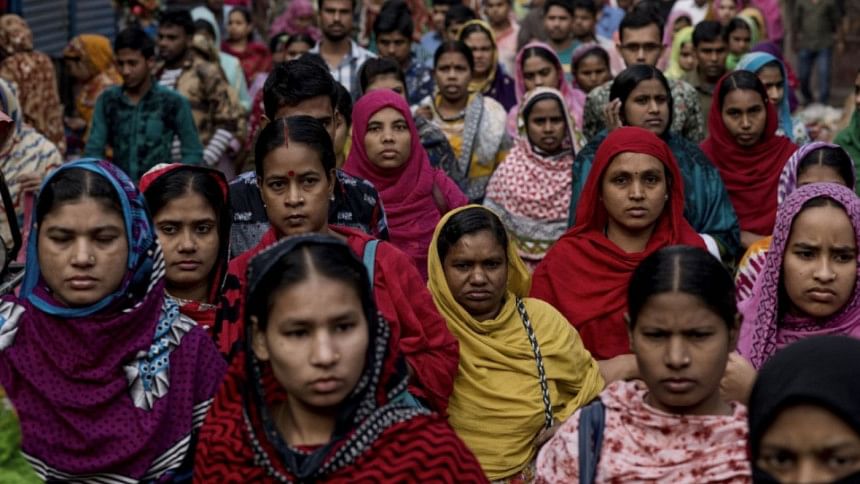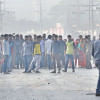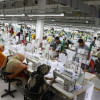Garment workers' struggle to find affordable housing

The garments industry plays a crucial role in our economy. The welfare of the 4.2 million workers in this industry is vital for our achievement of middle-income status. The sustainability of the RMG labour force, particularly those who can be considered blue-collar workers, needs to be given highest priority by all stakeholders, including BGMEA, industry owners, government, and the labour movement.
It goes without saying that if we are to achieve our export target of USD 50 billion by 2021, it is imperative for the government and RMG owners to keep an eye on not only the foreign exchange earnings or the profits made in RMG, but also on the workers' wellbeing and their job satisfaction. While doing some research on the issue of real wages in the RMG industry, I came across a revealing account of the pitiful conditions of the housing situation of those who work in this industry. Roughly 80 percent of the workers, mostly women, live in cramped quarters and half their wages often go towards rent.
A few years ago, Bangladesh Bank and BGMEA launched a programme to provide affordable housing for RMG workers with a pilot project in Ashulia. However, even if this enterprise gets off the ground, it is but a drop in the bucket since the housing crisis for low-income earners has gotten worse with every passing day.
Bruce Wallace in a report for PRI provides a breakdown of the budget for a typical worker. One-third of "Sabina's salary goes towards renting a bed in a small cinderblock room. Most mornings, she wakes up early and makes breakfast for her two roommates, as well as the three guys in the room next door." On the other hand, married female RMG workers often live with their family, including their husbands and children, in one room and share the bathroom and kitchen with other garment workers and their family members. While each RMG worker is expected to receive a housing allowance of Tk 2,050 according to the new wage scale, the average rent in most industrial clusters is Tk 5,000 for a two-bedroom unit.
During recent demonstrations in the streets carried out by RMG workers, ostensibly for better wages, it became clear that the workers need more than just a minimum wage. After all, Tk 8,000 per month does not go very far if rent and cost of living go up at the same time as the wages do. In a study conducted by Microfinance Opportunities (MFO), participants indicated that they could not pay rent and purchase basic necessities including food, clothing, and medicine by relying entirely on income generated from their minimum wage.
The ongoing MFO study mentioned above, known as "Garment Worker Diaries", collects weekly data on the work hours, income, expenses, and financial tool use of workers in the global apparel and textile supply chain in five producing countries, including Bangladesh. Preliminary findings show that "current rent levels are driving garment workers to accumulate debt in order to provide basic necessities for themselves and their families."
Another report entitled "High Rents Trap Bangladesh's Garment Workers in a Cycle of Debt" provides a comparative analysis of the financial transactions of the workers who live in rented accommodation versus those who do not. It portrays a stark contrast of the situation of these two categories of RMG workers, and how the renters are squeezed by their low income and the high cost of living in urban industrial zones. The economic behaviour of these two groups is very different even though their demographic characteristics are the same. The data makes it clear that rent is a huge burden for the two-thirds of women who pay it, costing 40 percent of their monthly paycheck. "These women purchase goods on store credit more than twice as often as the women who do not pay rent, borrowing goods each month with a value equivalent to almost 20 percent of an average paycheck. The goods they purchase are not luxuries; they borrow basics like food, soap, and medicine for themselves and their families."
One possible solution for the housing shortage and the cycle of debt that RMG workers face is the provision of subsidised housing within the factory premises or in the industrial zones created by the government. The idea has been recently embraced by advocates of workers' rights in Bangladesh.
Let's look at some numbers. The minimum wage went up from Tk 3,000 in 2010 to Tk 5,300 and, if implemented, will be Tk 8,000 in 2019. Unfortunately, Bangladesh's garment workers' overall cost of living has increased by 86 percent between 2013 and 2018 where food cost increased by 56.8 percent and non-food cost increased by 115.4 percent, according to a study by CPD. "Every time there had been a wage hike in the sector, it was accompanied by an instant rise in housing costs," concludes CPD's Dr Khondaker Golam Moazzem. "So, there would be no tangible improvement in the workers' quality of life after the wage raise," he adds.
It is fair to pause now and ask: is the demand for greater wages and affordable housing going to put the RMG owners in a financial crunch? This is a relevant question in view of the fact that we always hear from even the wealthiest RMG owners that they are not breaking even given the rising costs of production, compliance, and automation, not to speak of the pressure exerted by foreign competition. The short answer is: housing for workers is an investment with good returns.
In addition, for the RMG sector, there is some good news. A recent study conducted by two scientists at MIT, one of the top-rated academic institutions in the world, concludes that factories that treat workers well get more business.
They examined data on more than 2,000 manufacturers in 36 countries over a four-year period including China, India, Bangladesh, Indonesia, Vietnam, Thailand, Turkey, Philippines, Taiwan, Cambodia, and Pakistan.
The research paper concludes that those with improved compliance not only saw an increase in annual purchasing, but they were also producing better quality products and delivering them on time.
The Bangladesh government has an important role to play in ensuring affordable housing which is Goal 11 of the SDGs. Hardly a day goes by before a new report comes out that shows that affordable housing is becoming increasingly difficult to get. It appears that we are progressively heading towards a world where "roughly one in three people around the world could live in substandard housing or be forced to forgo other essentials, like medical care, to pay for their lodging" by 2025.
Advocates for inclusionary housing (also known as inclusionary zoning) have proposed that the government (including municipal and local authorities) pass an ordinance or enforce existing rules and regulations to require that a given share of new construction be made available to people with low to moderate incomes. Some portion of new housing projects can be reserved for the low-income bracket using land use regulations and a portion provided to them at an affordable price.
Dr Abdullah Shibli is an economist and works in information technology. He is Senior Research Fellow, International Sustainable Development Institute (ISDI), a think-tank in Boston, USA.

 For all latest news, follow The Daily Star's Google News channel.
For all latest news, follow The Daily Star's Google News channel. 








Comments